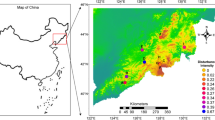Abstract
The arrangement of trees within a stand by location and age (stand structure) is in part determined by the life history strategy of the species and the disturbance history of the stand. In western North America such disturbances are often the product of wildfires and human management activities. The current study uses spatial analysis to characterize three stands of Pinus torreyana with known disturbance histories. Two stands are located at Torrey Pines State Reserve (TPSR). Of these, one stand has burned twice since 1972. Fire has been successfully excluded from the other stand since the early part of this century. A third stand, on Santa Rosa Island, Channel Islands National Park (SRI), has been grazed heavily since the mid-19th century and has not experienced fire since that time. One-hectare study plots were established in the interior of each stand. Considering the known life history attributes of P. torreyana, and the disturbance histories of the stands, predictions are made concerning the spatial characteristics of the respective stands. All trees within each study plot were sized by diameter breast height (DBH) and mapped. Three techniques of spatial analysis are applied to the resulting unweighted point pattern distributions and the distributions weighted by the square root of DBH as a surrogate for age. The results are consistent with predictions and confirm the following generalizations concerning patterns of aggregation in Torrey pine stands. Young trees tend to be more aggregated than old trees within the same stands. Young stands tend to be more aggregated than old stands on otherwise ecologically similar sites. On a periodically disturbed site there are clusters of trees that represent cohorts of post-disturbance recruitment.
Similar content being viewed by others
References
Biswell, H. H., Kallander, H. R., Komarek, R., Vogl, R. J. & Weaver, H. 1973. Ponderosa fire management. Misc. Pub. No. 2. Tall Timbers Research Station, Tallahassee.
Borchert, M. 1985. Serotiny and cone-habit variation in populations of Pinus coulteri (Pinaceae) in the southern coast ranges of California. Madrono 32: 29-48.
Bradley, A. F., Noste, N. V. & Fischer, W. C. 1988. Fire and the ecology of forests and woodlands in Utah. USDA Forest Service, Gen. Tech. Report INT-287. Intermountain Research Station, Ogden.
Cooper, C. F. 1960. Changes in vegetation structure and growth of ponderosa pine since white settlement. Ecological Monographs. 30: 129-164.
Cooper, C. F. 1961. Patterns in ponderosa pine forests. Ecology 42: 493-499.
Diggle, P. J. 1983. Statistical Analysis of Spatial Point Patterns. Academic Press, London.
Franklin, J., Michaelsen, J. & Strahler, A.H. 1985. Spatial analysis of density dependent pattern in coniferous forest stands. Vegetatio 64: 29-36.
Getis, A. 1984. Interaction modeling using second-order analysis. Env. PlanningA16: 173-183.
Getis, A. & Franklin, J. 1987. Second-order neighborhood analysis of mapped point patterns. Ecology 68: 473-477.
Griffin, J. R. & Critchfield, W. B. 1972. The distribution of forest trees in California. USDA Forest Service, Research Paper PSW-82/1972.
Grime, J. P. 1979. Plant Strategies and Vegetation Processes. John Wiley, New York.
Haase, P. 1995. Spatial pattern analysis in ecology based on Ripley's K-function: Introduction and methods of edge correction. J. Veg. Sci. 6: 575-582.
Harvey, L. E. 1989. Spatial and Temporal Dynamics of a Blue OakWoodland. PhD Dissertation. University of California Santa Barbara.
Keeley, J. E. & Zedler, P. A. 1998. Evolution of life histories in pines. In: Pp. 219-249. D. Richardson and R. Cowling, (eds) Ecology and Biogeography of Pines. Cambridge University Press.
Ledig, F. T. & Conkle, M. T. 1983. Gene diversity and genetic structure in a narrow endemic, Torrey pine (Pinus torreyana Parry ex Carr). Evolution 37: 79-85.
McMaster, G. S. 1980. Patterns of reproduction in Torrey pine. M.S. Thesis, San Diego State University.
McMaster, G. S. & Zedler, P. H. 1981. Delayed seed dispersal in Pinus torreyana (Torrey pine). Oecologia 51: 62-66.
Ord, J. K. and Getis, A. 1995. Local autocorrelation statistics: Distribution issues and an application. Geog. Anal. 27: 286-306.
Perry, J. P. Jr. 1991. The Pines of Mexico and Central America. Timber Press, Portland, Oregon.
Rathbun, S. L. & Cressie, N. 1994. A space-time survival point process for a longleaf pine forest in southern Georgia. J. Am. Stat. Assoc. 89: 1164-1174.
Ripley, B. D. 1979. The analysis of geographical maps. Pp. 53-72. In: Bartels, C. P. A.&Katellapper, R. H. (eds), Exploratory and Explanatory Statistical Analysis of Spatial Data. Nijhoff, The Hague.
Ripley, B. D. 1981. Spatial Statistics. John Wiley and Sons, New York
Rowe, J. S. 1983. Concepts of fire effects on plant individuals and species. Pp. 135-154. In: Wein, R. W. & MacLean, D. A. (eds), The Role of Fire in Northern Circumpolar Ecosystems. John Wiley and Sons, N ew York.
Scheidlinger, C. R. & Zedler, P. H. 1986. Response of Torrey pine to spring and winter controlled burns. Final Report Contract No.4- 400-5076. California Department of Parks and Recreation. San Diego State University.
Silvertown, J. W. 1982. Introduction to Plant Population Ecology. Longman, White Plains, New York.
Vogl, R. J., Armstrong, W. P., White, K. L. & Cole, K. L. 1988. The closed-cone pines and cypress. Pp. 295-358. In: Barbour, M. G. & Major, J. (eds), Terrestrial Vegetation of California. John Wiley and Sons, New York.
Waters, E. R. & Schaal, B. A. 1991. No variation is detected in the chloroplast genome of Pinus torreyana. Can. J. For. 21: 1832-1835.
Wright, H. A. & Bailey, A. W. 1982. Fire Ecology. John Wiley and Sons, New York.
Author information
Authors and Affiliations
Rights and permissions
About this article
Cite this article
Wells, M.L., Getis, A. The spatial characteristics of stand structure in Pinus torreyana. Plant Ecology 143, 153–170 (1999). https://doi.org/10.1023/A:1009866702320
Issue Date:
DOI: https://doi.org/10.1023/A:1009866702320




